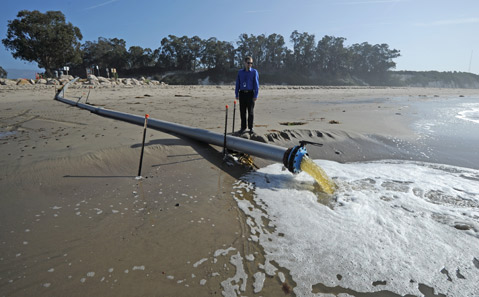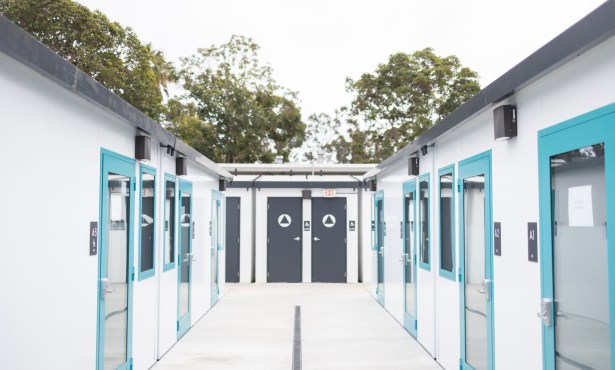Siphoning Off Goleta Slough
Steelhead Concerns Wrap Airport, Cities, County, State, and Feds in Coastal Conundrum

For more than two decades, the Goleta Slough’s naturally closing mouth has been regularly re-opened to the ocean by tractors from the County of Santa Barbara’s Flood Control District to stop the estuary from becoming stagnant, a situation that historically caused massive fish die-offs. The stagnant slough is also a problem for humans, due to the resulting stench, bugs, and, much more seriously, the risk of airplanes from the Santa Barbara Airport smashing into big birds like geese and ducks that congregate when the blocked waterway starts to pool.
But because federal regulators are worried about what opening the mouth might mean for endangered steelhead trout, the Goleta Slough has been silted-in since March, bird numbers are booming at the airport, and danger is rising faster than the water can recede. Last week, faced with few short-term options and no one else pursuing a long-range remedy, the City of Santa Barbara swooped in to tackle the bureaucratic nightmare — which is also causing trouble for the City of Goleta’s nearly $30 million San Jose Creek project — by siphoning off the slough into the ocean through a 12-inch wide pipe that now crosses the eastern edge of the Goleta Beach parking lot and will likely be there for a couple weeks to come. “It’s an interesting experiment,” said airport planner Andrew Bermond on Tuesday, bemoaning the whole situation and the siphon solution’s slower-than-expected flow, “but it’s definitely not a long-term solution.”
The saga begins in the early 1990s, when state wildlife officers worried about fish kills and the slough’s health asked Flood Control to periodically open the mouth, typically about two weeks after it silted in. “It wasn’t necessarily flood control, but it was one of those things we did and continued to do, and we thought it was a good thing,” said Tom Fayram, current head of the county district. By the mid-1990s, the district had to obtain long-term permits from the Army Corps of Engineers, and that wasn’t a problem until last fall, when the National Marine Fisheries Service expressed concern over impacts to steelhead, a species that wasn’t endangered when the breaching first began and is now known to be present in the watershed.
“We immediately saw that the requirements to make that happen were going to be so extraordinary and costly,” explained Fayram, so he decided to no longer pursue the permit because it would “drag down” the rest of his district’s countywide work. “And in the end, it’s not a flood control project.”
After last winter’s final permitted breach, shifting sands shut the slough in March, and by April, the presence of big birds was freaking out pilots and air traffic controllers at the airport, where take-offs and approaches had to be delayed so workers could chase geese and ducks off of runways. “It was something we did a couple times a year, and now we do a couple times a month,” explained Bermond, who is used to about a dozen Canadian geese in the spring, but said the numbers have swelled to more than 100, with similar boosts for other “problem birds” like duck and geese. “We can’t have bird numbers spike like this,” said Bermond. “That’s not a sustainable thing for us.”
It’s actually a bit of deja vu for Bermond, who recently led an innovative restoration project to return tidal flow to the slough in order to replace the large waterfowl that flock to seasonal, stagnant wetlands with smaller shorebirds that frequent coastal, regularly flushing estuaries. But that project, which was only approved after years of study and much back-and-forth with the Federal Aviation Administration, was contingent on the slough being mostly open. “It was understood that the maintenance permit would continue,” said Bermond, explaining that the feds’ concerns were a bit of a “late hit” for Flood Control. “With the slough mouth closed, we are back in the seasonal wetland scenario.”
The only option on the table — other than quickly killing dozens of birds — was to pursue an emergency breach permit from the California Coastal Commission, which recommended he check out the siphoning idea proposed by the City of Goleta, as the high water was affecting the San Jose Creek renovation. Since Goleta’s problem was just delayed construction and not a true emergency, Bermond “took up that project description and made it ours.” The City of Santa Barbara obtained the necessary permits on May 6 and, by that afternoon, the siphon was in place.
To date, a week later, only six inches of the required 2.5 feet have been siphoned off, a slower pace because the pipe gets clogged at night due to high-tide sands. But Bermond believes the water level will be properly reduced by the end of the 30-day permit, and is also taking on the job of applying again for the long-term permits that were dropped by Flood Control. “Our economic and ecological investment in the Goleta Slough depends on a tidal estuary,” said Bermond, but he’s mostly happy that no one’s been hurt yet. “We’re very lucky.”
Those who live or work nearby the slough may not, however, as mosquito numbers are exploding exponentially, according to Larry Fausett, general manager of the county’s Vector Management District. Normally, their overnight traps catch 250 bugs, or 500 in a bad season, but last week, the count was 25,000, and 97 percent of the bugs were the species that can carry West Nile Virus.
“It’s a classic example of single-species management being very short-sighted,” said Fausett, who previously ran operations for Flood Control and is quite critical of the feds’ steelhead clampdown. “If you try to do something for just one species and you don’t think of all the other species, you’re not doing your job.”



